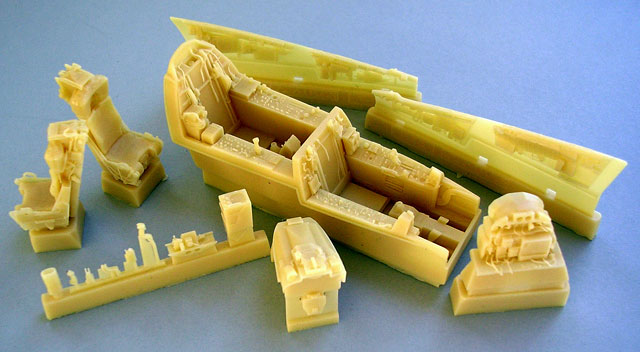|
|
S u m m a r
y |
|
Catalogue Number and Description |
Aires Hobby
Models 4226 - F-4G Phantom Cockpit for the Hasegawa kit |
| Price: |
USD$33.46 available online from Squadron.com |
| Scale: |
1/48 |
|
Contents and Media: |
Cream coloured
resin, acetate film, photo etched brass |
| Review
Type: |
FirstLook |
|
Advantages: |
Excellent detail and casting;
comprehensive photo-etch; solid packing |
|
Disadvantages: |
No painting
instructions |
|
Recommendation: |
Recommended
|
Reviewed by
Rodger Kelly

Aires' 1/48
scale F-4G Phantom II cockpit set is available online from
Squadron.com
Newly released from
Aires Hobby Models is 4226, a 1/48 scale mixed-media kit cockpit set for
the 1/48 scale Hasegawa kit of the Mc Donnell Douglas F-4G Phantom.
Nice! That was my first impression as I examined the pieces of this new
release from Aires. It certainly is very complete to say the least. It
comprises fourteen resin pieces, a photo-etched fret containing a twenty
eight pieces and a small piece of acetate that contains printed
instruments for the front and rear cockpits. The resin parts are cast in
the light cream coloured resin favored by Aires.

Click the thumbnails below to view larger images:
The photo-etch fret is
pretty comprehensive too. It contains in the main, parts for the canopy
rails, the instrument panels and the ejection seats harness. The metal
used by Aires to produce these frets is soft and easy to work with, much
like the lead you get from wine a bottle which is a good thing as it
easy to manipulate and drape the belts and harnesses onto the seats to
make them appear more realistic.
The casting of the resin parts really is great. The details are crisp
and include the myriad circuit breakers that abound in the F-4's
cockpit. I could not find any miscasts or pinholes in my sample at all.
Flash is at an absolute minimum too.
I can not rave too much about the casting on this cockpit set. Have a
look at the close-up pictures and you will see what I mean. The coiled
lead to the portable light in the front cockpit is an example of this.
Normally, you will see this lead as a one thick line with a few
corrugations. On this set, Aires have actually cast it so that it is a
coiled lead, just like the one-to-one-scale example. The undercuts too
are really something else! Aires has paid attention to the removal
process too by casting each part with a clear distinct line so you know
where the pour plug ends and the part itself begins.
The cockpit tub is cast as a single piece with the front and rear
bulkheads in place. I guess that they were thinking of ease of
construction here rather than ease of painting. Still, much of the tub
is dark gull grey anyway so it is not too much of a problem. The casting
on the tub also includes the throttle handles in the 'off' or throttled
back position. Aires seem to have been listening to comments made by
modellers with regard to the fitment of parts too as the cockpit
sidewalls (separate parts) will fit into a rebated groove cast into the
edges of the tub.
Does it fit? A cursory dry-fit of the tub itself (less the sidewalls)
into the fuselage of one my many un-built Hasegawa F-4 kits tells me
that it is not too wide and the length looks all right. However, be
aware that you will need to do a fair amount of work to modify the kit
to have it fit properly. Aires do warn you though that "Thinning of the
plastic parts and dry-fitting of the assembly needed!" but I guess that
you would not attempt fitting one of these kits unless you were prepared
to do a little cutting, filing filling, and sanding.
Is it accurate? Heck! Can I suggest that the cockpits of F-4Gs underwent
constant changes with removal of outmoded equipment and installation of
newer 'black boxes' in the thirty-odd years that the USAF alone flew it.
Just what Block Number this cockpit set is meant to replicate is not
advised by Aires.
A small instruction sheet is included. It carries 'exploded views' of
the suggested assembly sequence as well as a 'parts map' to assist you
in identifying the tiny resin parts.
What is missing though are painting instructions. Apart from a colour
photograph of the painted and assembled kit on the box top, nothing else
is included. But again, if you have gone to the trouble and expense of
purchasing this kit you probably already have some reference on your
shelves or know where to get it from.
The resin parts are packed in a zip-loc bag which is itself wrapped in a
small piece of bubble wrap. The photo-etch fret and acetate sheet are
placed into a plastic bag containing a piece of thick cardboard to keep
them flat. Both of these are then placed in a relatively fragile
cardboard box.
So is there a downside? In my opinion yes, the price. Squadron list 1/48
scale Hasegawa F-4G kits at $33.46. They list this set at $33.46.
Apart from the price, this kit is a cracker and is recommended.
Recommended.
Text and Images Copyright © 2005 by
Rodger Kelly
Page Created 19 May, 2005
Last updated 19 May, 2005
Back to HyperScale
Main Page
Back to Reviews Page
|
Home |
What's New |
Features |
Gallery |
Reviews |
Reference |
Forum |
Search